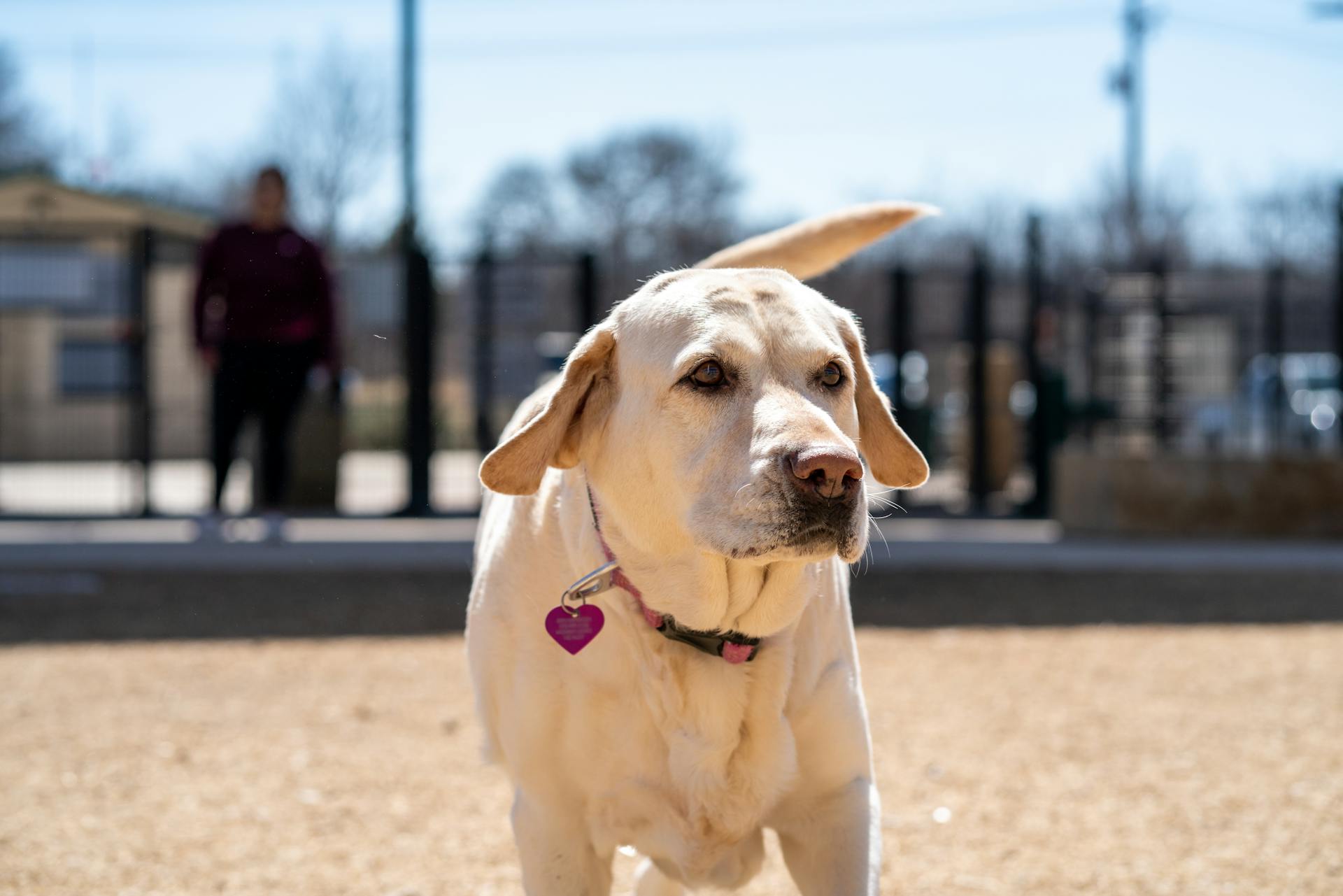
Dogs have a natural instinct to protect and care for their young, and stuffed animals often tap into this instinct.
Stuffed animals can provide a sense of comfort and security for dogs, much like a real baby would.
Dogs may see stuffed animals as a substitute for a real pup, and will often take on the role of a parent, guarding and caring for the toy.
This behavior is a sign of a dog's strong maternal instincts, which are still present even in adult dogs.
Instinctual Behavior
Dogs are natural-born hunters, and their prey drive is still intact today. They have an ingrained instinct to hunt and forage for their food, and this behavior can be triggered when they play with soft toys.
The thrill of catching prey is a big part of this instinct, and when dogs rip apart a stuffed toy, they might just be following their instincts. This behavior is a natural extension of their wild ancestors, who had to hunt and kill to survive.
A unique perspective: Canine Play Behavior
Dogs also exhibit residual nursing behaviors from their early development stages. They would lick their mother's belly to stimulate milk production during feeding, and this rhythmic motion brought comfort and feelings of satiation.
Some dogs instinctively recreate this licking behavior on objects like stuffed toys or blankets, seeking the same soothing effects. This is a sign that their emotional needs are being met, and they're finding comfort in the familiar motion.
Dogs have an innate urge to groom other members of their pack as a social bonding behavior. This grooming instinct stems from their ancestral origins as social animals that lived in packs. By licking and nibbling on stuffed toys, dogs are satisfying both their physical urge to groom as well as their emotional need for bonding and affection.
Here are some signs that your dog is exhibiting instinctual behavior with their stuffed toys:
- Excessive licking, mouthing, or nibbling of stuffed toys
- Hiding or burying stuffed animals around the house
- Guarding stuffed toys from other pets or family members
- Anxious or protective behavior if you try to remove a favored stuffed animal
Texture and Sensory Satisfaction
Dogs love the texture of stuffing material inside soft plush toys, and the sensation of tearing it apart with their teeth can be satisfying and provide sensory stimulation.

This is because the texture of the stuffing is appealing to dogs, and it's one of the reasons they enjoy chewing on stuffed animals.
Their excellent sense of smell also allows them to gather a great deal of information from the textures and scents of stuffed toys.
The moisture transferred by licking gives dogs chemical and sensory information about objects in their environment, which is essential for their curiosity and exploration.
Dogs use their licks to investigate the plush exterior, odd shapes, new smells, and any residues from manufacturing or even their owner's home.
Dogs and Toys
Dogs have a special way of interacting with toys that satisfies their instincts. Retrievers enjoy fetching balls or frisbees, while some hunting breeds like squeaky toys.
Some dogs develop an attachment to a toy and will always carry it around and cuddle with it. This attachment is not the same as mistaking the toy for a living animal, as dogs have extraordinary senses, particularly related to scent.
You might like: Why Do Dogs Have a Favorite Toy
Dogs can learn to recognize toys based on key sensory features, such as their appearance and smells. A study found that dogs can learn to associate a name with their favorite toys, like Border Collies.
In fact, 58% of dog owners report that their dogs lick or suck on blankets or toys, with 63% of female dogs exhibiting this behavior. This transference of emotional intimacy and attachment from human owners onto inanimate substitutes is a common phenomenon in dogs.
Dogs prefer to use visual cues to identify toys, but they can also use smell in certain conditions. A study showed that dogs can pick out their target toys in all conditions, but it took a bit longer in the dark.
Readers also liked: Crinkle Toys
Decoding Dog Behavior
Dogs have a unique way of interacting with toys, and it's not just about chewing or destroying them. In fact, some dogs can learn to recognize their toys based on key sensory features, such as appearance and smells.
Studies have shown that dogs can learn verbal names for their favorite toys, like Border Collies. A study published in Animal Cognition found that dogs can recognize toys based on their appearance and smells, and learn to associate a name with them.
Dogs tend to rely on visual cues to identify toys, but they can also use their sense of smell in certain conditions. In one experiment, dogs were able to pick out their target toys in both light and dark conditions, using a combination of visual and olfactory cues.
Here's a breakdown of the results:
It's clear that dogs have a complex way of distinguishing between their toys, and it's not just about instinct or habit. They're able to learn and adapt to new toys and environments, and even form emotional attachments to certain objects.
Some dogs may exhibit residual nursing behaviors from their early development stages, such as licking their mother's belly to stimulate milk production. This can lead to similar licking behaviors on objects like stuffed toys or blankets, seeking the same soothing effects.
In fact, studies suggest that up to 58% of dog owners report their dogs licking or sucking on blankets or toys. This behavior may be a sign of emotional attachment or intimacy with the object, much like children do with treasured stuffed animals or blankets.
You might like: Why Does My Male Dog Keep Licking My Female Dog
Final Thoughts
Dogs don't think they're living animals despite how they may act with stuffed animals.
Dogs are much smarter about their toys than we realize. They have an instinct to hunt, mother, or protect their resources, and stuffed animals give them an outlet for these instincts.
Dogs use multiple senses to locate their favorite toys, including sight, smell, and touch. This is according to a study that found dogs rely on multiple senses to find their toys.
Resource guarding is a common behavior in dogs where they become possessive of their toys and may even growl or snap if you try to take them away. This is because the toy has become a substitute for something more valuable to them.
Toys often satisfy an instinct in dogs to pounce and chew on things, which is a natural behavior for them.
Here are some common reasons why dogs like stuffed animals:
- Hunting instinct: Dogs have an innate instinct to hunt and chase small prey, and stuffed animals can satisfy this instinct.
- Mothering instinct: Some dogs may see stuffed animals as a way to nurture and care for something, which is a natural behavior for mother dogs.
- Protecting resources: Dogs may become possessive of their toys and see them as something to protect, which is a common behavior in resource guarding.
- Sensory stimulation: Stuffed animals can provide dogs with sensory stimulation through their texture, smell, and sound.
- Play and exercise: Playing with stuffed animals can provide dogs with exercise and mental stimulation, which is essential for their physical and mental health.
By understanding why dogs like stuffed animals, we can provide them with the right toys and stimulation to keep them happy and healthy.
Contents
Dogs interact with stuffed animals in a way that's both fascinating and endearing. They often carry them around in their mouths, which can be a sign of attachment and affection.
Dogs have a unique way of decoding behavior when it comes to toys, and stuffed animals are no exception. They can pick up on subtle cues, like the texture and scent of a toy, to determine its appeal.
Some dogs develop unhealthy toy behaviors, like obsessive attachment or destructive play, which can be a sign of underlying issues. It's essential to be aware of these signs and address them promptly.
Here are some key takeaways from our exploration of why dogs like stuffed animals:
- Dogs often carry stuffed animals around in their mouths, indicating attachment and affection.
- Dogs can pick up on subtle cues, like texture and scent, to determine the appeal of a stuffed animal.
Frequently Asked Questions
Do stuffed animals comfort dogs?
Yes, dogs can find comfort in stuffed animals, which can provide a sense of security and calmness during quiet time and stressful situations. This attachment can be especially beneficial for dogs that experience anxiety.
Do dogs like sleeping with stuffed animals?
Dogs often sleep with stuffed animals or other toys nearby, likely due to a natural instinct to keep them close in case they disappear. This behavior is a common quirk of canine companions who value security and familiarity.
Sources
- https://wagwalking.com/behavior/why-do-dogs-play-with-stuffed-animals
- https://wagwalking.com/behavior/why-dogs-like-stuffed-animals
- https://zachspetshop.com.au/blogs/guides-advice/why-do-dogs-like-to-pull-stuffing-out-of-toys
- https://www.dogster.com/lifestyle/do-dogs-think-their-stuffed-animals-are-real
- https://www.stuffedanimalstorage.com/why-does-my-dog-lick-stuffed-animals/
Featured Images: pexels.com


